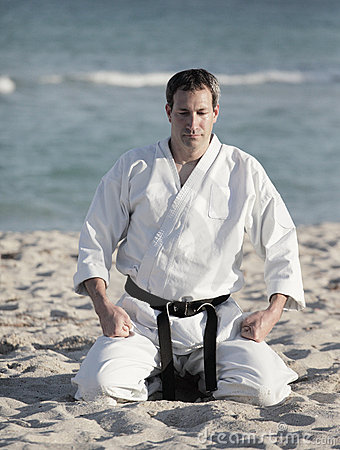Meditation
I know a lot of you guys don’t know this about me, but I did Karate for over 10 years. A big part of traditional martial arts practice includes meditation. Meditation has a lot of benefits chief of which are the ability to clear your mind, tune out distractions and focus on the present.
Meditation has been in the news a lot lately and I wanted to write about it, mainly because I know firsthand how it helps not only with calming your mind but keeping your body lean and healthy. It used to be a hippie thing to do but now everyone seems to be catching up and talking about it. Here is my take on it:
7 Reasons Why Meditation Is Good For You
- It can help your heart. That’s right! Several studies show that meditating twice a day for at least 15 minutes can lower your blood pressure and slash your risk for heart disease.
- It can reduce stress. There is tremendous benefit to shutting down your thoughts from time to time. You get a similar effect from hard training – you can’t think about other things while doing it. Many people have trouble quieting the mind (you can look at it as shutting down programs running in background mode). Mental stress causes oxidation of cells, just like physical stress.
- It can empower your workout. Practicing meditation increases your focus, helps your sleep at night and amps your energy levels. Interestingly, studies found similarities between the brain waves of athletes and those who meditated.
- It can keep you looking younger. There has been a positive correlation between meditation and telomere length, a marker of aging. People who meditate rate younger than their age consistently.
- It can help you lose weight. You heard it! It’s actually quite simple, when you are not stressed, you eat less. Plus your body doesn’t produce as much cortisol, a chemical responsible for keeping the weight on.
- It will improve your immune system. Meditating boosts antibodies in our system and that neutralizes viruses and bacteria, and creates a healthy immune system.
- It can help with cravings. Mindful eating is nothing to laugh at. Most of the time we don’t even think of what we are putting into our bodies. Meditation helps us control cravings and overeating
- It can help you achieve goals. Whether it’s losing weight or being more spiritual, meditation pushes the worries of the past and the future away, and allows you to be aware, and in the present, which in turn creates a more fulfilled existence.
How To Meditate
 You can do an internet search about “how to meditate” and you’ll get plenty of results: some simple with a few steps and some more in depth with multiple steps and helpful (or confusing) info.
You can do an internet search about “how to meditate” and you’ll get plenty of results: some simple with a few steps and some more in depth with multiple steps and helpful (or confusing) info.
What I’m going to provide is how we used to meditate in Karate practice.
We would normally practice meditation from kneeling position. I know it’s uncomfortable. Shutting out the discomfort enhances your ability to “tune out” distracting thoughts.
Next we would focus on our breathing. The sensei referred to this as belly breathing. Inhale bringing the air fully down into the abdominal cavity, rather than just the ribcage. To be clear, we are expanding both the ribcage and the abdomen on the inhale and fully expelling our breath on the exhale, pulling the abdominals back in. You can focus on pulling your belly button towards your spine on the exhale.
The timing was generally 3 seconds inhale and 3 seconds exhale. You can edit the time as you see fit but faster isn’t better.
If you haven’t tried mediation, I suggest to give it a try. I believe it will change your life and at least help you with your fitness goals.

Mindfulness Meditation
Mindfulness is a type of meditation in which you focus on being intensely aware of what you’re sensing and feeling in the moment, without interpretation or judgment. Practicing mindfulness involves breathing methods, guided imagery, and other practices to relax the body and mind and help reduce stress.
Section 1: What is mindfulness?
Most people understand mindfulness as the act of taking small, quiet time each day for you and focusing on your breathing. In reality, mindfulness means a lot more than that. The Buddha described mindfulness as the act of one mind that is fully alert and aware of what is happening in the present moment, as well as one mind that remains aware of the past and future, without judgment.
The word “mindfulness” itself is derived from the Sanskrit word “metta” or loving kindness. This means that in mindfulness you notice and pay attention to your positive and negative experiences, but you do so with kindness, openness and acceptance. It means you don’t judge or blame yourself or others, and you don’t overanalyze or overreact.
How does mindfulness work?
Mindfulness helps you become more aware of your own feelings. For instance, when you’re talking on the phone with your friend, you might focus on how you are feeling in the moment. For some people, this helps them feel more connected to their friends. For others, it makes them feel judged or even stressed out.
Mindfulness can help you become more aware of the outside world, and be less caught up in your own thoughts and emotions. This helps you more effectively navigate the stressors that happen around us on a daily basis. If you’re involved in an argument or stressed about your job or your finances, mindfully observing your emotions, feelings, and thoughts can help you get a more accurate idea of what’s really going on in your life.
Benefits of Mindfulness
Here are a few reasons you should consider trying mindfulness.
- Helps you understand and gain clarity about your emotions.
- Learning how to stay present can help you to better cope with the highs and lows of life.
- Helps to develop self-awareness and reduce emotional reactivity.
- Helps you regain control of the controllable.
According to James Baughman, a trauma therapist and certified mental health counselor, “… mindfulness is really about the ability to experience and live in your own life fully, in a healthy, compassionate, and self-accepting way. Learning how to manage your emotions, your moods, your reactions to situations, and learning how to respond and how to see your world in a healthy and compassionate way, are a key part of the practice of mindfulness.
Reducing Stress
Mindfulness meditation is highly accessible to all and can be practiced at any time, no matter where you are in the world. If you haven’t started it already, why not give it a try?
Now that the holidays are approaching, the stress levels have been increasing for both you and your family, so it’s the perfect time to begin meditation to help reduce stress and get you back on track in the new year.
Know of other ways to reduce stress and keep your body and mind healthy? Share them in the comments section below.
Improving Focus
If you want to be more focused at work, you need to be practicing mindful meditation. When you are distracted, your mind moves from one task to another, and when it moves, you are moving with it. By practicing mindful meditation, you can remove some of your habitual stressors from your life and experience more calmness.
When you practice mindful meditation regularly, it helps you relax and focus on the present moment. People who practice mindfulness are less likely to dwell on the past and dwell more on the future.
Learning meditation will improve your focus and encourage you to see the world from another perspective. Most managers and employees are stressed and need some relaxation.
Promoting A Deeper Connection to Yourself and Others
Mindfulness is known for promoting a deeper, more conscious connection to yourself and others. It helps you live more consciously and compassionately, and it helps you bring more authenticity into your life. As a result, you will feel more connected, fulfilled, and supported in your life, and this will likely improve your relationships and make you feel like you are better able to empathize and relate to others.
You’ll feel calmer, calmer, and calmer—and it will show! People will notice your new demeanor and see a noticeable change in your energy level. You’ll be more at peace.
How to practice mindfulness
According to the journal Mindfulness, “Practicing mindfulness means developing the capacity to be completely present in the present moment, regardless of your thoughts, emotions, or perceptions.” You can do this by following these steps:
Relax your body and mind as much as you can. Focus on your breathing. Note the sensations in your body. Notice thoughts and emotions as they arise. Don’t judge them. Instead, try to observe them without judgment. Try to empty your mind of negative thoughts. As you focus on each part of your body, say your name or another affirmation to yourself or something to focus your attention on. Pay attention to your bodily sensations. Feel yourself moving, your breathing, and the breath itself.
Breathing Methods
The first breathing method is known as “three-part breathing,” which is based on the concepts of prana and pratyahara (also known as “the flow of the energy,” or Prana). In the Three-Part Breath, you begin breathing out by inhaling through your nose, then you breathe in through your mouth, and finally you exhale through your mouth. You repeat this three times and you’ll notice how your body becomes more relaxed and your mind becomes more focused. If you struggle with breathing on your own, you can use a machine like the Aural Rehabilitation Vibe Station.
You can also use guided imagery to induce a state of relaxation and facilitate meditation. Guided imagery typically involves visualizing a calming scene or a pleasant situation in your imagination and bringing it to life.
Guided Imagery Practices
Mindfulness meditation involves taking a moment to focus on your breath, and then imagine that you are taking a deep breath in and you are taking a slow breath out. If this helps bring your mind to stillness, that’s a good sign.
These activities are designed to get you focused on your breath, and then guided imagery practices.
Daily Sitting Meditation
- Sit on a chair with your back straight.
- Place your hands on your lap, fingers pointing forward.
- Close your eyes and breathe in for five seconds.
- Pause and notice how your breath feels.
- Focus on your breathing.
- Let your awareness of your breath become like a string that goes through your body.
- Breathe out for five seconds.
Mindfulness is one of the most beneficial aspects of getting into your favorite hobbies or activities. Here are two easy ways to start your journey. Give mindfulness a try by meditating or practicing a new hobby that calms your mind.
By trying mindfulness you can ensure that you’re not worrying about things that don’t matter. It can even eliminate any problems you have or give you more opportunities to experience life to its fullest. Mindfulness can improve your relationships, career, and finances.

